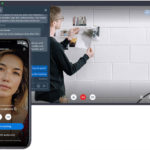How Alcatel Lucent Enterprise is driving channel with its transformation experience

Alcatel-Lucent Enterprise is a 100-year old company with a deep history of research and development. This long baseline of experience in innovation also gives it an advantage in understanding the process of digital transformation. “We have this history of transformation with us since the last 100 years. We can understand every step that you are in for your digital transformation,” says Rukmini Glanard, EVP Global Sales and Marketing, Alcatel-Lucent Enterprise.
As an example, she points out, “The idea of BOTS is as exotic today as the telephone 100 years ago.”
Alcatel-Lucent Enterprise operates across four country regions and is predominantly active in 30 countries more than others. It has three solution groups including communication products, network on demand, and cloud-based integration platform called Rainbow.
While using the Rainbow cloud, every user has access to various communication APIs to interface with the applications of their choice. All three solution groups offer an on-demand consumption model in addition to the capex model, for example switch as a service.
While Alcatel-Lucent Enterprise has demerged from modern day Nokia, it continues to cross-sell partnering with Nokia, over switching and wireless access points, mobility and switching, and beyond the edge devices. Says Rukmini, “We have privilege agreements with Nokia, and Alcatel-Lucent Enterprise is their go-to-market partner for enterprise solutions.”
Alcatel-Lucent Enterprise engages with 2,800 global channel partners and maintains an indirect go-to-market sales model. The vendor continues to retain its historical partners, who have been engaged for the last ten to twenty years with it. While continuously asking itself, what is the value and business benefits we can bring to customers in the market, Rukmini points out, “We have not lost any partners.”
As a company, Alcatel-Lucent Enterprise has been traditionally selling boxes out there in the market to integrators who have been deploying those boxes. “My approach with the team is to say this is not way to do business anymore.” Rukmini is now advocating that channel partner engage with customers in their transformation projects, consult with the vendor on possible solutions, and then offer those back to the customer.
“We give you a value add that you can monetise back to your customer, adding services that you can sell back to the customer. This is transformation,” she explains.
For any organisation, in the process of digital transformation, there are two aspects that they need to be managed. One is technology and the other is people. Inside an organisation, especially those that are larger with a longer baseline of operations, there are different generations of people.
“Most of the transformations fail because the adoption of users behind them are not synchronised and people are expecting different things from the transformation. Everybody has their opinion – some want stick to what is there and others want to change,” she reflects.
The way forward for Alcatel-Lucent Enterprise channel partners is to recognise that end customers are pursuing transformation in a certain context. Their needs and demands are specific. Channel partners need to pursue an integrated approach across the customer’s ecosystem, allowing the company to interface with the customer and the customer to interface back.
Alcatel-Lucent Enterprise has been traditionally strong in select vertical markets including healthcare, education, hospitality, transport, and government. The value proposition from the vendor is based on its use cases across these verticals, that it offers its channel partners.
Rainbow CPaaS
CPaaS stands for Communications Platform as a Service. It is a cloud technology that allows users to integrate real-time communications into existing business applications without complex engineering. CPaaS bridges communications between humans, objects and processes, enabling faster, secure digital engagement for business.
The solution includes; real-time relationship machine connecting customer service players; library of connectors to connect objects, processes, applications; cloud-based development platform and APIs to integrate Rainbow capabilities into business applications; community of developers.
To better understand the evolution of the connected experience and where CPaaS is headed, Alcatel-Lucent Enterprise has worked with Wainhouse Research and interviewed more than 300 enterprises. Key takeaway: 85% of the respondents believe their organizations could make better connections using newer technology.
Alcatel-Lucent Enterprise’s approach is based on hybrid cloud architecture, meaning the users can connect their existing communication system to the cloud to minimise transformation costs.
Real-time communications services such as text messaging, voice, video and conferencing services, can be directly connected to business processes and applications, which helps make conversations relevant and professional. Employees connect to customers using their preferred way: office phone, mobile handset, smartphone, softphone.
Key takeaways
- Inside an organisation, especially those with a longer baseline of operations, there are different generations of people.
- Most of the transformations fail because the adoption of users behind them are not synchronised.
- Everybody has an opinion some want stick to what is there and others want to change.
- Channel partners need to recognise that end customers are pursuing transformation in a certain context.
- Alcatel-Lucent Enterprise has been traditionally strong in markets including healthcare, education, hospitality, transport, and government.
- The value proposition from the vendor is based on its use cases across these verticals, that it offers its channel partners.





